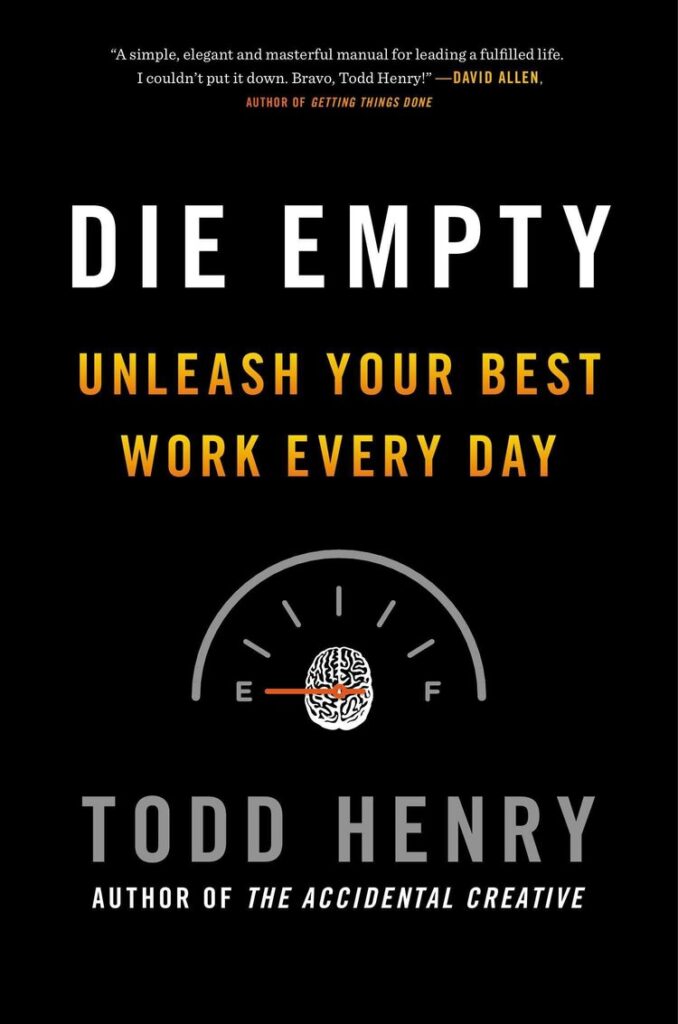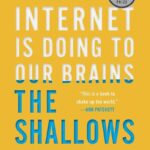In DIE Empty: Unleash Your Best Work Every Day, founder and CEO of Accidental Creative Henry Todd provide a framework for having a sense of urgency and doing our most important work every day.
Die Empty is a tool for people who aren’t willing to put off their most important work for another day. Todd Henry explains the forces that keep us in stagnation, and introduces a process for instilling consistent practices into your life that will keep you on a true and steady course.
Book Premise
- The DIE Empty book is about cultivating the mindset and the methods you need to unleash your best work each day, and to increase the odds that, at the end of your life, you will not regret how you spent your days.
Book Goal
- To bring a newfound clarity and sense of urgency to how you approach your work on a daily basis, and over your lifetime
We have only a certain amount of time available to us, and how we choose to spend our days is significant. We’re also aware that there are things we would like to do and experiences we would like to have before we die, many of which are desires we’ve suppressed for months or even years. We feel the ticking of the clock, and the accompanying sense that we may be missing our opportunity to make a contribution to the world. However, we often ignore these impulses as a result of the relentless pragmatics of life and work.
What DIEing Empty is not
It’s not about ignoring all areas of your life so that you can exclusively focus on getting work done. In fact, working frantically is actually counterproductive in many cases. Emptying yourself of your best work isn’t just about checking off tasks on your to-do list; it’s about making steady, critical progress each day on the projects that matter, in all areas of life. Embracing work with this mind-set will not only increase your chances of tackling your goals, but will also make it all more gratifying.
Take a stand—don’t shape-shift
You are better positioned to make a contribution if you align your work around your values. Don’t be a mirror, passively reflecting the priorities of others. You must dig through the rubble to the core principles that guide your life, come hell or high water. Then commit to engaging your work with a clean conscience, knowing that you are holding true to those principles. There is plenty of room to experiment and try new things, but if you don’t stand for what you believe in, you will eventually lose yourself in your work.
Urgency vs Diligence
Urgency means leveraging your finite resources (focus, assets, time, energy) in a meaningful and productive way. Diligence means sharpening your skills and conducting your work in a manner that you won’t regret later. When you adopt the mind-set of urgent diligence, you’ll pour all of who you are into your days, and subsequently you’ll find that the unique value you bring to the world comes more clearly into focus.
The Three types of Work
Even though work sometimes feels like one massive, melded blend of tasks, conversations, and meetings, it can be parsed into three different forms: Mapping, Making and Meshing.
Mapping
It’s planning, plotting your objectives, and setting priorities. It’s the “work before the work” that helps you ensure you’re spending your focus, time, and energy in the right places. You often map instinctually, as when you make a list of tasks to accomplish, or block off time on the calendar. Sometimes mapping is also done in collaboration with others, such as in strategy meetings or planning sessions.
Making
Making is actually doing the work. It’s creating value of any kind, including executing tasks, making sales calls, designing, writing, engaging with your direct reports, and tackling your objectives. Making is what typically comes to mind when you think of work, because it is what you’re doing when you deliver the most tangible value.
Meshing
Meshing involves all of the “work between the work” that actually makes you effective. It’s composed of activities that stretch and grow you, such as acquiring and developing new skills, reinforcing or enhancing your knowledge, cultivating your curiosity, or generating a better understanding of the context for your work.
Body of Work
You are building a body of work today through both what you do and how you do it. Whether or not your body of work is recognized for its true value is beyond your control. Regardless, the contribution you make will be accomplished through the use of all three kinds of work (Making, Mapping, Meshing). The degree to which your contribution reflects your true potential will be largely determined by how disciplined you are about improving your self-awareness and skills every day.
Success in emptying yourself of your best work each day depends on your ability to define the right battles, and do the small but critical tasks that will help you progress toward your true objectives rather than just the ones that others expect you to strive for.
Great work requires suffering for something beyond yourself. It’s created when you bend your life around a mission and spend yourself on something you deem worthy of your best effort. What is your worthwhile cause?
Priorities
Priorities are difficult. When you choose one thing to focus on, you automatically choose not to focus on others. This is why some people fall into aimlessness: they don’t like the discomfort of having to say no to very good things that aren’t the most important things. They’d rather be mediocre at a lot of things than take a real swing at things they care about and risk failure.
Affinities
These are similarities you notice between the project you’re working on and other experiences you’ve had. Connecting these dots can be a helpful way to spark new creative insights or possible paths to pursue in your work.”
We learn best within the context of what we already know. If we have mental “hooks” on which to hang new experiences, then we are more likely to retain that new knowledge and leverage it in future problem solving. Compare your current difficulty with products on the market, people, circumstances, ideas, or anything at all that you can use to glean patterns of similarity.
Don’t Give In to the “Lag”
The lag is the gap between cause and effect. It’s the season between planting a seed and reaping a harvest. It’s the time when all the work you’ve done seems to have returned little to no visible reward, and there is little on the horizon to indicate that things are going to get better.
When you are in the lag, the only thing that keeps you moving forward are (a) confidence in your vision and ability to bring it to fruition, (b) a willingness to say no to other things that tempt you to divert from your course, and (c) daily, diligent, urgent progress.
Two things will paralyze our creativity faster than anything else:
1. We haven’t defined success.
2. We haven’t defined failure.”
“If we don’t have a clear definition of what we’re trying to do, we will spin out. Simultaneously, if we don’t have a clear definition of “missing the mark,” we will experience paralysis.”
All the best in your quest to get better. Don’t Settle: Live with Passion.



Comments are closed.